Update: New Steller’s Sea Cow Sighting? WA 2010
Posted by: Loren Coleman on September 23rd, 2010
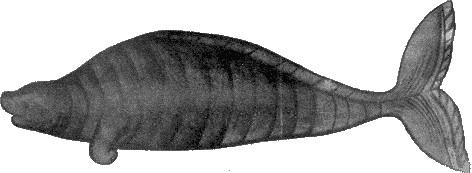
Eyewitness Chuck Crosby shares a new encounter of some interest:
“I was tuna fishing with a friend last week about 40 miles off out between Willipa Bay and Long Beach (off Washington State) and saw this huge thing in the water just bobbing around. I thought it was a log/stump or something. I trolled toward it and it just sat there watching us as we trolled by. I stayed about a hundred feet or so away from it. My fishing buddy (who owned and operated commercial fish and crab boats in Alaska for decades) just looked at it and we could not figure out what the heck it was. On the evening of 9/20/2010, as I was telling my daughter about it, my wife looked up manatee on the internet and THAT WAS IT!!!
“I did the research and couldn’t figure out how that thing could possibly be in our Washington State waters. Then I found this site and read about the Steller’s Sea Cow that was spotted a few years ago [Washington State, 2006]. It was in generally the same area and I am sure that it was the same type of animal.”
A selection of passages from The Field Guide to Lake Monsters, Sea Serpents, and Other Mystery Denizens of the Deep details old and recent encounters with Steller’s Sea Cows.
In followup questioning of Mr. Crosby, he filled in more details about his encounter:
What color was it? What did it look like?
“It was dark like very dark gray or black. I did not get close enough to it to tell if it had smooth skin or if it had whiskers or hair. It did not have hair like a person.”
Did you take a photograph of it?
“This is the embarrassing part. I did not take a picture. My buddy and I were trolling for tuna and it had been pretty quiet for a while. The water was very calm last Tuesday [September 14, 2010] and the fog was always there but it would kind of lift up and settle down. At the time we saw this thing it was lifted pretty good and it almost looked like the sun might break through. Anyway I saw this thing from quite a distance away and changed my troll to get over that way to see what it might be. We see stuff floating in the water sometimes and I thought it looked weird for a stump or something so I trolled that way. I deliberately did not troll right toward it as I got closer because I could see it was some kind of animal or something and I did not want to scare it away. We trolled right past it at about 50 to 100 feet away and it did not go away. I had a camera on the boat but I was thinking what the heck is that thing, when I get home I am going to look that up and see what it is. It looked somewhat familiar but I just couldn’t remember what.
“I had no idea that it was something that should not be there or that was totally out of its normal habitat. Just the head was out of the water and I
didn’t think that it would take a very good photo so I didn’t bother with the camera. I really regret that now.”
What was it doing?
“Like I said earlier it was just floating out there in the water with only its head and maybe a little shoulder above the water. It did look old but I have no idea about that. It did not appear to be threatened or afraid and as I said it watched us for well over 5 minutes and maybe ten. I did not even notice as we trolled away if it went under the water or was still floating.We just kind of forgot about it.”
Did you report the sighting to anyone?
“I really haven’t told anyone about the sighting except the wife and daughter until Monday night when they looked it up and found that this might have been a very rare sighting. Since then I have only spoken with a few people about it at my office.”
Do you think anyone else saw it?
“There were a couple of other commercial boats working the area at the time but were probably not within sight distance of the animal at the same time that we were there. There was one big boat out there with orange buoys out and it looked like they were long lining for something although we could not figure that out either because is was around a thousand feet deep there.”
How was your day otherwise?
“We did have a pretty good day of tuna fishing. We are pretty new at the tuna thing but it was a nice day. We caught a few and if we had been a little more experienced I am sure we would have done better.”
Please tell me more about the drawing you did.
“I am a horrible artist. I did draw it for my wife after I got home and she recognized it as a manatee right away.”
More recently, as cited in the field guide, marine biologists Bret Weinstein and James Patton of the University of California have noted that there are vague reports of Steller’s Sea Cows from along the northwest coast of North America and the northeast coast of Asia, in the Arctic Ocean and Greenland. If such reports are not discounted, then Hydramalis gigas stelleri, or a subspecies, may still be alive today.
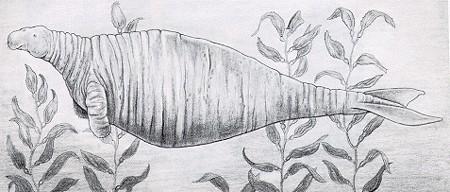
This sighting occurred on September 14, 2010. Can’t get news any hotter than this. Taking into account all of the marine mammal laws, some organization in Washington State should send out a search party to see if it is still around and take some photographs!!
++++
Updated with drawings, which do appear to mirror the look of a sea elephant.
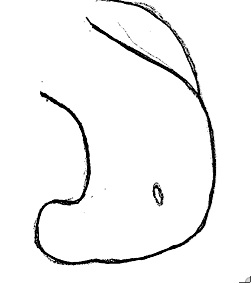
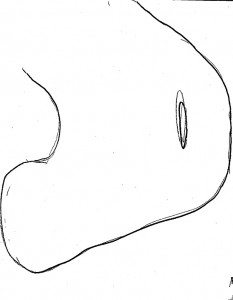
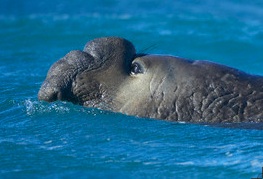
Mature sea elephant.
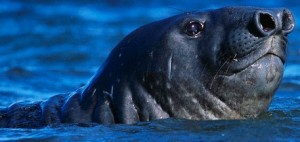
Young sea elephant swimming.
About Loren Coleman
Loren Coleman is one of the world’s leading cryptozoologists, some say “the” leading living cryptozoologist. Certainly, he is acknowledged as the current living American researcher and writer who has most popularized cryptozoology in the late 20th and early 21st centuries.
Starting his fieldwork and investigations in 1960, after traveling and trekking extensively in pursuit of cryptozoological mysteries, Coleman began writing to share his experiences in 1969. An honorary member of Ivan T. Sanderson’s Society for the Investigation of the Unexplained in the 1970s, Coleman has been bestowed with similar honorary memberships of the North Idaho College Cryptozoology Club in 1983, and in subsequent years, that of the British Columbia Scientific Cryptozoology Club, CryptoSafari International, and other international organizations. He was also a Life Member and Benefactor of the International Society of Cryptozoology (now-defunct).
Loren Coleman’s daily blog, as a member of the Cryptomundo Team, served as an ongoing avenue of communication for the ever-growing body of cryptozoo news from 2005 through 2013. He returned as an infrequent contributor beginning Halloween week of 2015.
Coleman is the founder in 2003, and current director of the International Cryptozoology Museum in Portland, Maine.










I would absolutely love for this sighting to turn out to be true, but I have to remain skeptical, at least as far as it’s being a Steller Sea Cow specifically. Whether some other species of manatee, dugong or sea cow, or some other unknown species could be living off of coastal Washington, I don’t know, but the natural history of the Steller Sea Cow, at least what has been speculated about it, suggests that the remanant populations that were recorded by Steller during his voyage with Vitus Bering in 1741, were able to survive in those isolated islands alone (they were not widespread and not very large populations even before their modern discovery) as they served as refugias with the specific kinds of habitat and conditions they required and which had all but disappeared from the North Pacific since the re-submergence of Beringia following the end of the Ice Age. At that point Beringia would have blocked cold arctic water from the North Pacific while warmer tropical currents would pool along those shores and those kinds of conditions will not return until Beringia itself does. Whether they would have managed to linger there in their refugia(s) if left undisturbed until a new Ice Age returned and the conditions for which they were adapted were once again widespread enough for their populations and range to expand (they at one time were present in the islands of Norther Japan and Coastal California according to the fossil record), are unknown.
One distinctive characteristinc of the Stellers Sea Cow that the witness did not report, and maybe he could have, was the texture of the skin which Steller reports as being like deeply furrowed bark, moreso than in any other sirenian or any other large oceaninc animal that I know of likely to be found lounging on the surface.
And while I’m skeptical that its a Sea Cow, I am reminded of the sudden appearance of a grey whale in the eastern Mediterranean Sea off the coast of Israel earlier this year. I haven’t heard that it’s even been seen again since then. If that can happen, I have to wonder if other species are there and we just don’t see them, recognize it, or realize what they are.
Dogu4 writes: “Whether some other species of manatee, dugong or sea cow, or some other unknown species could be living off of coastal Washington, I don’t know….”
Of course, a sighting of any of those species off the coast of Washington State would be remarkable.
As to the texture of the skin being “like deep furrowed bark,” remember two items from this new sighting: (1) the eyewitness describes that in the fog, he kept his distance so as not to scare the animal, and (2) he said it looked “old.”
Ask yourself: Would not a furrowed animal’s skin give the impression to most people of being something that would be associated with an “old” animal?
Just food for thought.
A couple of data seem to be mssing from the narrative – we are not told the size of the object and are not told that it showed any sign of being alive.
If this information is available I would like very much to see it. otherwise how does it differ from a typical water-worn log ?
I don’t see anything here that rules out an elephant seal, do you? Not with fog and distance.
To directly answer Matt’s question, “no.”
This story is certainly exciting, but I have a couple of questions about it.
First of all – size?
The witness does not mention any guess at a length for this creature, and anything down around ten feet will bring obvious comparisons to known pinnipeds.
If an estimate puts it at twenty feet or so, then we are in an interesting place.
Secondly – location?
40 miles off the coast in deep (1k feet) water. Are not sirenians denizens of shallow coastal waters, biding their time wallowing in weeds? I don’t know of any bullkelp that reach lengths of 1k feet.
Having said that, I am a huge fan of Steller’s Sea Cows and would like nothing more than for them to be rediscovered. Fingers crossed. 🙂
Think Matt is spot on about it being a northern sea elephant.
All sirenians are shallow, coastal water bottom-feeders without exception. Finding any species 40 miles off shore is about as likely as spotting a sea otter. About zero.
However, the location is ideal for a northern sea elephant which feed far off shore at depths of from 700 to 2,500 feet. Given it’s unusual probiscus, I’d strongly guess a male, which can grow to 14 feet in length.
Finally, no surprise the witness would select a picture of a manatee. From William Dampier onward, early sea captains and scientific observers commonly referred to sea elephants as “manatees.